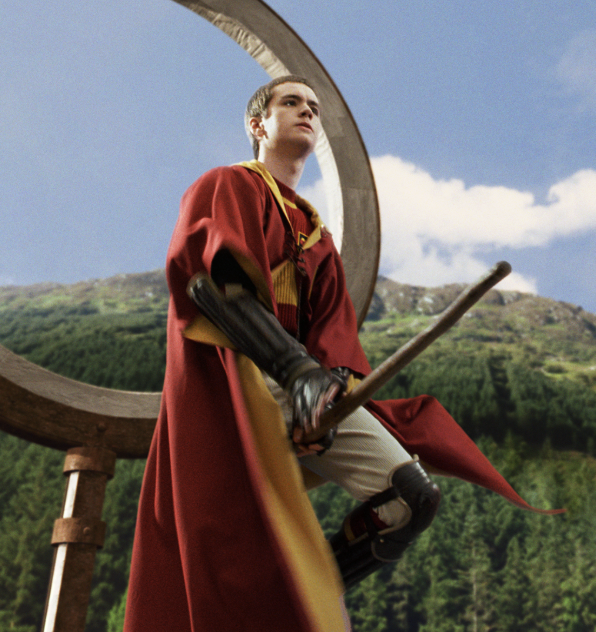One of the things that stands out as a contrast across the movie adaptations of Mrs. Rowling’s books is the tone. Starting especially with the third movie, and proceeding more or less steadily onwards, the movies get both darker and more mature. The entire school ages as Harry does in the movie adaptations; this is not in fact just my interpretation, some of the commentary in the interviews attached to the DvDs released includes statements along the lines of “They are older now so …”
This age bias in the movies stands out most clearly in the depictions of the Quidditch games. In the first movie they are all depicted in flowing brightly coloured robes. There is little to no padding, and despite the bludgers racing about, seemingly none needed. There is a cartoon element (that is, frankly, present in the books as well) that wizards can seemingly take, and shrug off, the incredible damage that an iron ball roughly the size of a cannon ball, flying around at high speed1 would do on impact the human frame. Later movies are frankly still ridiculous in terms of the actual damage a bludger would actually do, but there is a greater acknowledgement that Quidditch is indeed an incredibly rough sport. The players start to look more like a rugby team, both in their uniforms, and in the blood stained and bruised visages we see them sporting in the few shots the later movies give us of the practice times and games. Compare these Oliver Wood from the first year to Ron as Keeper in the later movies, both from trailers:


Both have gauntlets with built in gloves, but Oliver’s are finger-less. You cannot see them here, but both have essentially the same shin guards. The big difference though is that Ron has on both chest and head padding reminiscent of vintage American football gear.2 Because Harry is now older, a team sport which fields players across all seven years now suddenly requires padding.
There is a similar bias going on in the books when it comes to romance. Mrs. Rowling was attempting to write a book series for children. As such, including age-appropriate details of fifteen, sixteen and seventeen year old attempts at romance in a boarding school setting simply … was not appropriate. She had a couple of mutually exclusive and (from a world builder’s perspective) unpalatable options.
- On one hand, the teachers and prefects can have a firm handle on discipline. The school is then firmly stuck in the Victorian ages, the students are adequately chaperoned, and the resulting student culture is firmly repressed. You will not, as is occasionally seen in in the later movies, see inappropriate (for a public setting) behaviour in the common rooms or hallways, because the prefects put a stop to any such nonsense. That is assuming that the students in question would even behave in an inappropriate manner in the first place, because they come from highly repressed families where they have been brought up to think of kissing and relations between young men and women in Victorian terms. The problem with this is that there is the occasional innuendo that indicates otherwise, noticeably Mrs. Weasley’s occasional anecdotes of her own time in Hogwarts.
- On the other hand, we could admit that Hogwarts is incredibly short staffed, and the (presumed) six prefects per house almost certainly inadequate to handle (minimally) nine floors of the castle,3 four common rooms, and seven years (per house) of male dorm rooms (the girl’s dorms are out of bounds for this kind of behaviour). Anyone who has chaperoned teens can testify that they are not always cognisant of their surroundings, or mindful of the number of potential spectators. Hormones have a tendency to override rational behaviour. The problem with this is that the books would quickly include elements that might be acceptable in a teen fantasy or romance novel, but not in a children’s book. It might also easily get in the way of the plot - Harry would far less frequently find the common room empty if couples were free (or even just felt free) to engage in amorous behaviour in them after the first years should be in bed.
- She could heavily leverage the fact that the books are blind to anything that Harry is not paying attention to. This seems to be the route she takes. Harry is constantly worried about one crisis or another. Occasionally he surfaces from this, but like many teens, his focus is quite firmly fixed on his own concerns. He can be incredibly observant, he is also incredibly oblivious. This is why the socially inept Hermione can get away with her condescending description of Cho’s emotional roller coaster in Harry’s fifth year - because for all his glances at her, he has not really paid attention to her (he does not know about any of the struggles Hermione describes). However, in choosing to go this route, while it nicely navigates between both of the problems of the first two approaches, rams head on into both of them in a more limited sense: Harry’s own relationships. There is a reason why the books can smoothly transition from Harry’s arrival at the Weasley’s house to the departure for King’s Cross weeks later, or transition from Christmas to the Harry’s third Quidditch game of the year. Obliviously there were things that Harry himself noticed during these times. He interacted with class mates in class far more than the few limited interactions we see in the books. He interacted with other Gryffindor students in the common room far more than we see in the books. And he naturally interacted with Ginny, at least in the later books, far more than we have ever seen. While these interactions might fit the third person limited narration, Mrs. Rowling was constrained to thread a path between possibility numbers one and two, and ruthlessly omits most human interaction to maintain that child like tone. Too much towards number one, and Harry cannot be a child hero. Too much towards number two, and we cannot have a child audience.
From a world building perspective, this leaves us incredibly unsatisfied. What are we to make of the random suggestive comments in the plot that she has, probably purposefully, left to the imagination? Things like the fact that there seems to be only one changing room per (co-ed) team, or that the prefect’s bathroom is 1) singular (not plural, one for each gender), and 2) in a hallway a fair distance from any common room (are the prefects going to take a bath then walk down the hall in a bath robe?). How does Oliver wake up the girls for the surprise early morning Quidditch practice when boys cannot access the girl’s dorms? Are the girl’s dorms in Ravenclaw less protected than those in Gryffindor, or is there an exception to allow a male teacher to bypass those protections (the head of house Ravenclaw is male…)? If there is such an exemption, is that the magical world being too trusting of teachers because we see that kind of excessive trust in authority, or because it is too stuck in the past (we see examples of that as well)?
Other fan fiction authors have picked up on the disturbing implications of Lockhart’s use of memory charms in a school fool of teenage girls who have a crush on him. The man clearly had the kind of personality and ego for that to be a problematic temptation. The same has been noted, generally by different authors, of Moody’s magical eye and its ability to see through things.
Each of these potential contradictions simply begs to take the books in a more … adult direction. That direction would certainly expose a massive element of moral ambiguity into the series that simply does not belong in a book aimed at children, and arguably does not belong in a book aimed at teens.
They do make for interesting speculation though.
The brooms can go up over 100 miles an hour, and the bludger can catch up to players on them.↩︎
Mr. Ivan Cores. “The History of Football’s Protective Gear” The Hitching Post 2023-03-16.↩︎
The exact number of floors is really subject to a great deal of speculation, because we have mention of at least seven floors, but there are also the various towers.↩︎